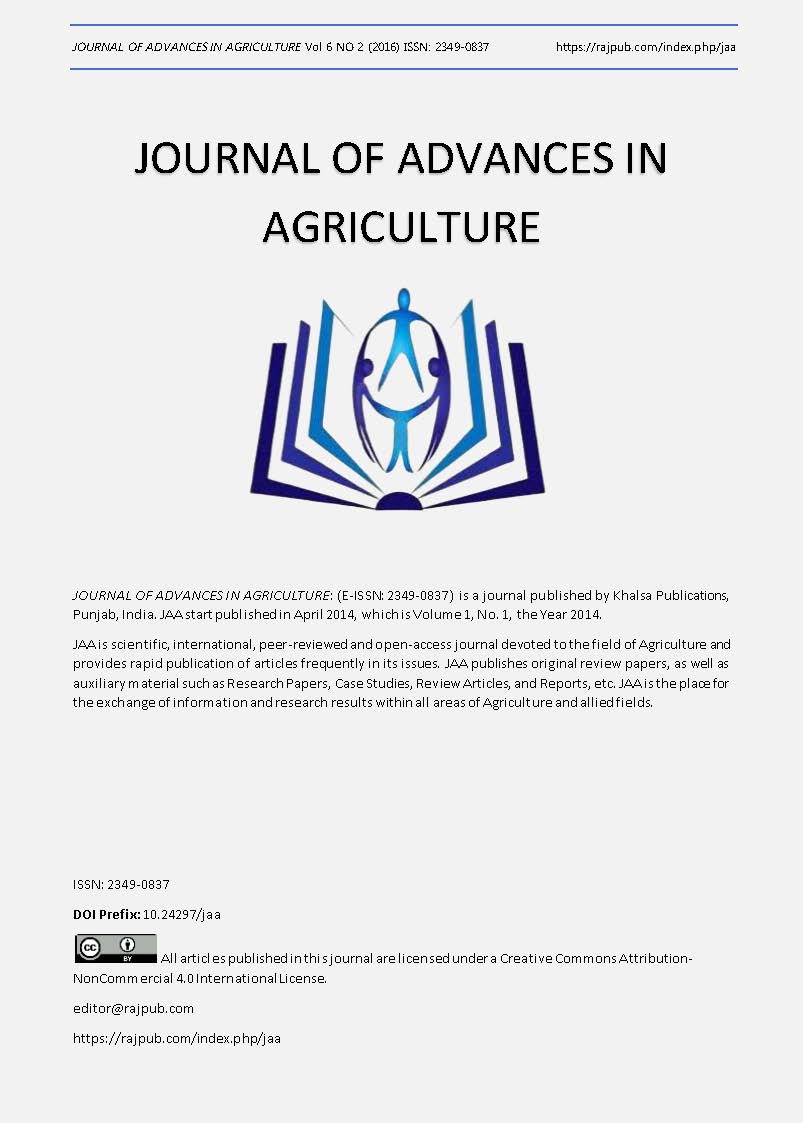Phenological and Physiological Study of Six Cultivars of Ziziphus spp. Planted in Basra Province- Iraq.
DOI:
https://doi.org/10.24297/jaa.v6i2.7329Keywords:
Phenological, Physiological, Ziziphus, Cultivars, BasraAbstract
This study was conducted in a private orchard at Abu Al Khasib area in Basra province – Iraq, during the growing season (2013), to evaluate six cultivars of Ziziphus spp. Plant, phenologically and physiologically. The results confirmed a difference among the cultivars in some phenological characteristics, and a similarity in others. While in physiological characteristics, and a similarity in others. While in physiological characteristics the study showed a significant superiority of the Toffahi cultivar in its length, diameter and weight of fruits (4.00 cm, 3.26 cm and 7.30 g.) respectively and in its fruit dry weight percentage (42.38 %), while the Hindi cultivar was superior in the T.S.S., water content and phenols percentages (17.22, 67.36 and 2.21 %) respectively. But the Laimoni cultivar was superior in leaf area, adjustable total acidity percentage and calcium pectate percentage (6.78 cm2, 0.81 % and 4.57%) respectively. While Bathri cultivar was significantly superior in total chlorophyll content (3.36 mg. 100-1 fresh weight). Whilst the rest of cultivars showed a variable differences among them.
Downloads
References
2. Ackly, W. B. and Krueger, W. H. 1980. Overhead irrigation water quality and cracking of sweet cherries. Hort. Science, 15: 239 – 290.
3. Al-Izairjawi, R. A. E. 1988. Physiological development of Ziziphus spina-christi (L.) fruits C.V. Bambbawi and Mallasi. M. Sc. Thesis, College of Agriculture, University of Basra.
4. Al-Rawi, Kh. M. and Khalaf Allah, A. A. M. 2000. Designation and analysis of agricultural experiments. Directorate of Book HouseFor Publishing and pressing. Mosul University, Iraq. (in Arabic).
5. Association Official Analytical Chemistry (A. O. A. C.) 1970. Official methods of analysis. 2nd ed., Washington, D. C., USA.
6. Arndt, S. K. 2000. Mechanisms of drought resistance in the tropical fruit tree Ziziphus. Ph. D. thesis, University of Vienna, Austria.
7. Dvornic, V. 1965. Lucrary practice de Ampelografie Ed didaetiea Sipdagogiea Bucuresti, Pomania. [C. F. Vit. Culture by/ Al-Saidi Part I, 2000 (in Arabic)].
8. El-Alwani, A. M. and Ammari, S. S. 2001. Fruit physical characteristics of date palm cultivars grown in three Libyan Oases proceeding of second International Conference. Date Palm, Al-Ain: 662 – 670. By: www. acthort.org.
9. Howrtiz, W. (Ed.) 1975. Official methods of analysis. Association of Official Analytical Chemistry, Washington D.C., USA, Pp. 425.
10. Johnston, M. C. 1975. Rhomnaceae. In:flora of tropical East Africa, eds. Milne Red Head, E. and Polhill, R. M., Crown, Agents, London.
11. Lang, A. and During, H. 1990. Grape berry splitting and some mechanical properties of the skin. Vitis, 29: 61 – 70.
12. Mohamad, M. and Sallanon, H. 2006. The effects of extraction methods on major fatty acid composition, antioxidant content and sensory quality in Dan Virgin Olive Oils Produced in Syria. D. J. A. S., 22 (1): 223 – 234.
13. Morton, J. 1987. Indian Jujube. Pp. 272 – 275. In: Fruits of warm climates Julia F. morton, Miami, F1.
14. Nasri, M. B. and Nabli , M. A. 2006. Flora Biology study of Ziziphus lotus L. Acta Horticulture 840: International Jujube Symposium.
15. Pareek, O. P. 2001. Ber. International Centre for Underutilized Crops, Southampton, UK, Pp. 291.
16. Rouhani, I. and Bassiri, A. 1976. Changes in the physical and chemical characteristics of Shahani Dates during development and maturity. Hort. Sci., 51, 480 – 494.
17. Shawky, I., Yosif, M., and El-gazzar, A. 2001. Effect of nitrogen fertilization in Sewy Date Palm. The international Conference on Date Palm, Assiut University, Center for Environmental Studies – Egypt, pp: 3 – 16.
18. Williams, J. T. 2006. Introduction, taxonomy and history. In: Williams, J. other Jujubes. Southampton, Centre for Underutilized Crops., Chap. 9, pp: 1 – 17.
Downloads
Published
How to Cite
Issue
Section
License
 All articles published in Journal of Advances in Linguistics are licensed under a Creative Commons Attribution 4.0 International License.
All articles published in Journal of Advances in Linguistics are licensed under a Creative Commons Attribution 4.0 International License.




